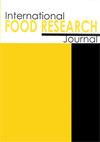Parboiling of pigmented and non-pigmented Philippine rice (Oryza sativa L.) cultivars: Textural properties and carbohydrate quality
IF 1
4区 农林科学
Q4 FOOD SCIENCE & TECHNOLOGY
引用次数: 0
Abstract
Parboiling improves rice carbohydrate quality, which is beneficial for diabetes management in Asia. However, parboiling drastically alters cooked rice texture, making it unappealing for Filipinos, who generally prefer tender cooked rice. The present work evaluated the carbohydrate quality and cooked rice hardness of nine local pigmented and non-pigmented rice varieties as affected by parboiling and cooking treatments. The amylose content (AC), retrogradation potential (RP), and resistant starch (RS) content were determined, and the samples with the highest RS were further investigated for their thermal properties and starch morphology. Results showed that parboiling increased RS level by as much as five-fold, particularly in the red rice Minaangan, which had intermediate AC and the highest RP (2,821.5 cP) among the samples. The highest RS, 2.71 ± 0.02 g/100 g, was recorded in parboiled NSIC Rc 222 cooked at 1:2.5 (rice:water). It also produced soft cooked rice, which was significantly better than its non-parboiled counterpart. High proportion of water needed to gelatinise parboiled non-pigmented NSIC Rc 222 was due to higher starch crystallinity as indicated by its gelatinisation enthalpy and intact starch granule. In conclusion, parboiling and cooking at appropriate rice:water ratio of NSIC Rc222 and Minaangan could deliver healthier cooked rice with Filipino preferred textural quality.色素和非色素菲律宾大米(Oryza sativa L.)栽培品种的煮沸:纹理特性和碳水化合物质量
煮沸可提高大米碳水化合物的质量,在亚洲有利于糖尿病的控制。然而,沸煮会极大地改变大米的口感,使大米变得不好吃,因为菲律宾人通常更喜欢口感细嫩的大米。本研究评估了九个本地色素和非色素大米品种的碳水化合物质量和熟米硬度受煮沸和烹饪处理的影响。测定了淀粉含量(AC)、逆变潜能值(RP)和抗性淀粉(RS)含量,并进一步研究了抗性淀粉含量最高的样品的热特性和淀粉形态。结果表明,煮沸可使抗性淀粉含量增加五倍之多,尤其是红米米南干,其抗性淀粉含量在所有样品中居中,抗性淀粉降解潜能值(RP)最高(2,821.5 cP)。以 1:2.5 的比例(米:水)煮熟的国家科学与工业研究中心 Rc 222 的 RS 值最高,为 2.71 ± 0.02 克/100 克。煮出的米饭也更软,明显优于未经沸煮的同类产品。从糊化焓和完整的淀粉颗粒来看,沸煮非色素糙米 Rc 222 的淀粉结晶度较高,因此糊化糙米 Rc 222 所需的水比例较高。总之,以适当的米:水比例沸煮和烹饪新国标 Rc222 和 Minaangan 可提供更健康的熟米饭,并具有菲律宾人喜欢的口感质量。
本文章由计算机程序翻译,如有差异,请以英文原文为准。
求助全文
约1分钟内获得全文
求助全文
来源期刊

international food research journal
Agricultural and Biological Sciences-Food Science
CiteScore
1.40
自引率
0.00%
发文量
75
期刊介绍:
The International Food Research Journal (IFRJ) publishes papers in English, six (6) issues a year with the coverage of:
Food Science and Technology
Nutrition and Dietetics
Agriculture, multidisciplinary
Chemistry, multidisciplinary
The scope of the Journal includes:
Food Science, Food Technology and Food Biotechnology
Product Development and Sensory Evaluation
Food Habits, Nutrition, and Health
Food Safety and Quality
Food Chemistry, Food Microbiology, Food Analysis and Testing
Food Engineering
Food Packaging
Food Waste Management
Food Entrepreneur
Food Regulatory
Post-Harvest Food Management
Food Supply Chain Management
Halal Food and Management
 求助内容:
求助内容: 应助结果提醒方式:
应助结果提醒方式:


